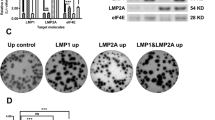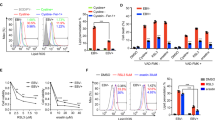Abstract
Epstein-Barr virus (EBV)-encoded latent membrane protein 1 (LMP1) has been demonstrated to be linked to the pathogenesis of nasopharyngeal carcinoma (NPC), one of the most common cancers in southeast Asia as well as in the areas of southern China. RNA-cleaving DNAzymes are catalytic nucleic acids that bind and cleave a target RNA and have been increasingly used to inhibit gene expression. In this study, we aimed to explore the effects of down-regulation of LMP1 by DNAzymes on the NPC growth using a mouse xenograft model derived from human NPC C666-1 cells that constitutively express the LMP1. A specific LMP1-targeted DNAzyme, named DZ509, was synthesized, showing high activities in the inhibition of LMP1 expression, while the control DNAzyme (mutDZ509) had little effect on LMP1 expression. Knockdown of the LMP1 expression by DZ509 reduced cell proliferation and increased apoptosis compared to the cells transfected with mutDZ509. Intratumoral injections of DZ509 into C666-1 xenografts caused a significant suppression of tumor growth compared to mutDZ509-treated xenografts. Examination of the LMP1 expression in the xenografts demonstrated a marked inhibition of LMP1 by DZ509. An antisense oligonucleotide targeting the same site of the LMP1 transcripts was employed in parallel and produced a comparable inhibition on cell proliferation in vitro and tumor growth in vivo. These data demonstrate that LMP1-targeted DNAzyme is efficient in controlling tumor growth in vivo, and thus may have therapeutic implications in the treatment of NPC.




Similar content being viewed by others
References
Mutirangura A, et al. Genomic alterations in nasopharyngeal carcinoma: loss of heterozygosity and Epstein–Barr virus infection. Br J Cancer. 1997;76:770–6.
Chan AT, Teo PM, Johnson PJ. Nasopharyngeal carcinoma. Ann Oncol. 2002;13:1007–15.
Spano JP, et al. Nasopharyngeal carcinomas: an update. Eur J Cancer. 2003;39:2121–35.
Li XP, Li G, Peng Y, Kung HF, Lin MC. Suppression of Epstein-Barr virus-encoded latent membrane protein-1 by RNA interference inhibits the metastatic potential of nasopharyngeal carcinoma cells. Biochem Biophys Res Commun. 2004;315:212–8.
Lee AW, et al. Retrospective analysis of 5037 patients with nasopharyngeal carcinoma treated during 1976–1985: overall survival and patterns of failure. Int J Radiat Oncol Biol Phys. 1992;23:261–70.
Wang WY, et al. Plasma EBV DNA clearance rate as a novel prognostic marker for metastatic/recurrent nasopharyngeal carcinoma. Clin Cancer Res. 2010;16:1016–24.
Seto E, Ooka T, Middeldorp J, Takada K. Reconstitution of nasopharyngeal carcinoma-type EBV infection induces tumorigenicity. Cancer Res. 2008;68:1030–6.
Lu JH, et al. Epstein-Barr virus facilitates the malignant potential of immortalized epithelial cells: from latent genome to viral production and maintenance. Lab Invest. 2010;90:196–209.
Lin X, et al. EBV-encoded LMP1 regulates Op18/stathmin signaling pathway by cdc2 mediation in nasopharyngeal carcinoma cells. Int J Cancer. 2009;124:1020–7.
Jiang R, Cabras G, Sheng W, Zeng Y, Ooka T. Synergism of BARF1 with Ras induces malignant transformation in primary primate epithelial cells and human nasopharyngeal epithelial cells. Neoplasia. 2009;11:964–73.
Sivachandran N, Sarkari F, Frappier L. Epstein-Barr nuclear antigen 1 contributes to nasopharyngeal carcinoma through disruption of PML nuclear bodies. PLoS Pathog. 2008;4:e1000170.
Yoshizaki T, et al. Induction of interleukin-8 by Epstein-Barr virus latent membrane protein-1 and its correlation to angiogenesis in nasopharyngeal carcinoma. Clin Cancer Res. 2001;7:1946–51.
Murono S, et al. Induction of cyclooxygenase-2 by Epstein-Barr virus latent membrane protein 1 is involved in vascular endothelial growth factor production in nasopharyngeal carcinoma cells. Proc Natl Acad Sci USA. 2001;98:6905–10.
Kondo S, et al. EBV latent membrane protein 1 up-regulates hypoxia-inducible factor 1 alpha through Siah1-mediated down-regulation of prolyl hydroxylases 1 and 3 in nasopharyngeal epithelial cells. Cancer Res. 2006;66:9870–7.
Horikawa T, et al. Induction of c-Met proto-oncogene by Epstein-Barr virus latent membrane protein-1 and the correlation with cervical lymph node metastasis of nasopharyngeal carcinoma. Am J Pathol. 2001;159:27–33.
Zheng H, Li LL, Hu DS, Deng XY, Cao Y. Role of Epstein-Barr virus encoded latent membrane protein 1 in the carcinogenesis of nasopharyngeal carcinoma. Cell Mol Immunol. 2007;4:185–96.
Mei YP, et al. Silencing of LMP1 induces cell cycle arrest and enhances chemosensitivity through inhibition of AKT signaling pathway in EBV-positive nasopharyngeal carcinoma cells. Cell Cycle. 2007;6:1379–85.
Dass CR, Choong PF, Khachigian LM. DNAzyme technology and cancer therapy: cleave and let die. Mol Cancer Ther. 2008;7:243–51.
Isaka Y. DNAzymes as potential therapeutic molecules. Curr Opin Mol Ther. 2007;9:132–6.
Yu SH, Wang TH, Au LC. Specific repression of mutant K-RAS by 10–23 DNAzyme: sensitizing cancer cell to anti-cancer therapies. Biochem Biophys Res Commun. 2009;378:230–4.
Liang Z, et al. DNAzyme-mediated cleavage of survivin mRNA and inhibition of the growth of PANC-1 cells. J Gastroenterol Hepatol. 2005;20:1595–602.
Liu C, Cheng R, Sun LQ, Tien P. Suppression of platelet-type 12-lipoxygenase activity in human erythroleukemia cells by an RNA-cleaving DNAzyme. Biochem Biophys Res Commun. 2001;284:1077–82.
Lu ZX, et al. DNAzymes targeted to EBV-encoded latent membrane protein-1 induce apoptosis and enhance radiosensitivity in nasopharyngeal carcinoma. Cancer Lett. 2008;265:226–38.
Lu ZX, et al. Effect of EBV LMP1 targeted DNAzymes on cell proliferation and apoptosis. Cancer Gene Ther. 2005;12:647–54.
Liu H, et al. LMP1-augmented kappa intron enhancer activity contributes to upregulation expression of Ig kappa light chain via NF-kappaB and AP-1 pathways in nasopharyngeal carcinoma cells. Mol Cancer. 2009;8:92.
Abdelgany A, Uddin MK, Wood M, Taira K, Beeson D. Design of efficient DNAzymes against muscle AChR alpha-subunit cRNA in vitro and in HEK 293 cells. J RNAi Gene Silencing. 2005;1:88–96.
Sriram B, Banerjea AC. In vitro-selected RNA cleaving DNA enzymes from a combinatorial library are potent inhibitors of HIV-1 gene expression. Biochem J. 2000;352(Pt 3):667–73.
Guasparri I, Bubman D, Cesarman EEBV. LMP2A affects LMP1-mediated NF-kappaB signaling and survival of lymphoma cells by regulating TRAF2 expression. Blood. 2008;111:3813–20.
Deng L, et al. Cells in G2/M phase increased in human nasopharyngeal carcinoma cell line by EBV-LMP1 through activation of NF-kappaB and AP-1. Cell Res. 2003;13:187–94.
Mei YP, Zhu XF, Zhou JM, Huang H, Deng R, Zeng YX. siRNA targeting LMP1-induced apoptosis in EBV-positive lymphoma cells is associated with inhibition of telomerase activity and expression. Cancer Lett. 2006;232:189–98.
Du C, et al. Downregulation of Epstein-Barr virus-encoded latent membrane protein-1 by arsenic trioxide in nasopharyngeal carcinoma cells. Tumori. 2006;92:140–8.
Ho CH, Chen CL, Li WY, Chen CJ. Decoy receptor 3, upregulated by Epstein-Barr virus latent membrane protein 1, enhances nasopharyngeal carcinoma cell migration and invasion. Carcinogenesis. 2009;30:1443–51.
Li L, et al. Latent membrane protein 1 of Epstein-Barr virus regulates p53 phosphorylation through MAP kinases. Cancer Lett. 2007;255:219–31.
Terrin L, et al. Latent membrane protein 1 of Epstein-Barr virus activates the hTERT promoter and enhances telomerase activity in B lymphocytes. J Virol. 2008;82:10175–87.
Kim KR, et al. Transformation of Madin-Darby canine kidney (MDCK) epithelial cells by Epstein-Barr virus latent membrane protein 1 (LMP1) induces expression of Ets1 and invasive growth. Oncogene. 2000;19:1764–71.
Yang X, et al. LMP1 of Epstein-Barr virus induces proliferation of primary mouse embryonic fibroblasts and cooperatively transforms the cells with a p16-insensitive CDK4 oncogene. J Virol. 2000;74:883–91.
Yang L, et al. Effect of DNAzymes targeting Akt1 on cell proliferation and apoptosis in nasopharyngeal carcinoma. Cancer Biol Ther. 2009;8:366–71.
Barton BE, Murphy TF, Shu P, Huang HF, Meyenhofer M, Barton A. Novel single-stranded oligonucleotides that inhibit signal transducer and activator of transcription 3 induce apoptosis in vitro and in vivo in prostate cancer cell lines. Mol Cancer Ther. 2004;3:1183–91.
Mitchell A, Dass CR, Sun LQ, Khachigian LM. Inhibition of human breast carcinoma proliferation, migration, chemoinvasion and solid tumour growth by DNAzymes targeting the zinc finger transcription factor EGR-1. Nucleic Acids Res. 2004;32:3065–9.
Author information
Authors and Affiliations
Corresponding author
Rights and permissions
About this article
Cite this article
Ke, X., Yang, Yc. & Hong, Sl. EBV-LMP1-targeted DNAzyme restrains nasopharyngeal carcinoma growth in a mouse C666-1 xenograft model. Med Oncol 28 (Suppl 1), 326–332 (2011). https://doi.org/10.1007/s12032-010-9681-2
Received:
Accepted:
Published:
Issue Date:
DOI: https://doi.org/10.1007/s12032-010-9681-2




